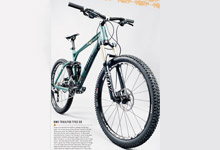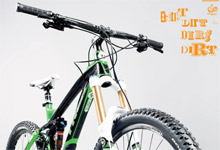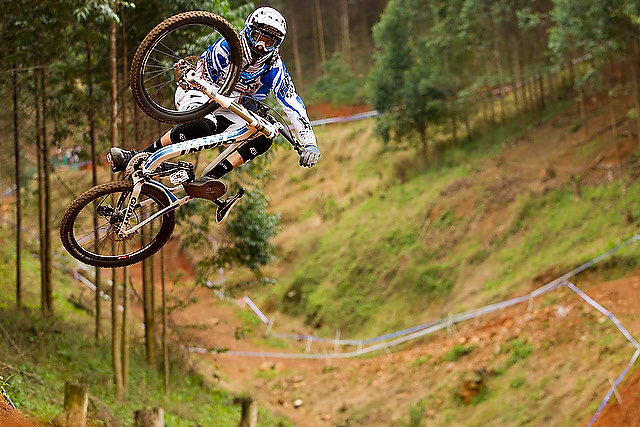Do you think 29ers should be allowed to race World Cups?
Regular readers of Dirt Magazine will be familiar of the feature we call the Question. In issue #120 we asked Jeff Steber, Todd Seplavy and Chris Conroy the 29er question and thought it would be good to throw open the internet doors and hear what you lot think about the big wheeled bikes on the WC stage.
Have a read and tell us your thoughts.

THE QUESTION 120
There has been an awful lot of talk on the internet recently on the rise of the 29” wheeled bike. There are plenty of hardtail and short travel 29” bikes out there in the market now, in fact pretty much every major bike manufacturer has them in their range, but what about downhill racing?
Intense did make their 2951 (a 29” 951) back in early 2010, running upside down Manitou Dorado forks (one way of getting around the larger front wheel problem). And forks, strong wheels and tyres are a problem at the minute at the more extreme end of the mountainbike spectrum, but will somebody turn up at the first round of this year’s World Cup on a 29” bike ready to race? It has been allowed in XC for a few years now, seemingly without too much concern, but is it right for downhill racing? On a relatively simple and pedally track like Pietermaritzburg a 29”er would surely be quicker (?). So…
…Hypothetically, if Aaron Gwin (or any of the top racers) turned up at the first round of this year’s World Cup in South Africa on a 29” downhill bikes do you think they should be allowed to race? And do you think 29” wheeled bike should be banned form World Cup Downhill races?

JEFF STEBER MAIN MAN AT INTENSE CYCLES
That’s a good one and we do have some experience with this as we have been experimenting with 29 DH for a couple of years now with the 2951, and we are currently making an M29. So you can guess that we believe in some of the benefits, and they become even more pronounced when things get really rocky, steep and loose….mud? Well that’s another story.
This whole scenario could actually be a reality as we are preparing an M29 for Florent Payent who rides for Suspension Center team we sponsor. Flo is a good candidate for 29, as he is a world class DH racer and happens to be around 6′ 2″. There are some equipment issues to work out, mainly in front suspension.
Last WC season showed quite some success in the XC ranks with 29ers taking some top results and at Worlds, and it seems to have been accepted and I can’t imagine it was overlooked. Maybe because these were the top teams (biggest companies) and maybe it would have been a different story if the underdogs had the edge?
I think innovation is always great for a sport, so bring it on, and it is always good for healthy debates and arguments. I do believe from our experience that with the right set–up and on the right track there could be definite advantages, no question.
I always think back to when Doug Henry was the first to run the YZ400 F (four stroke MX bike) during a whole season of supercross and outdoor. He roared against a field of buzzing bees (2 strokes) and he focused on riding that bike for its strengths. After that season of huge success the rest is history. 29 DH needs a Doug Henry and a team willing to take it on and prove it to the world. Now that would turn some heads!
TODD SEPLAVY SENIOR PRODUCT MANAGER AT GT BICYCLES
I am a tall American who personally likes big wheels for XC, favours technical progression of the sport, prefers speed over fashion, and works for a company that makes a ton of 9R models. Unless there is a rule on the books limiting a wheel size, then I see no reason a rider should be DQ’d for using a 29” wheel bike.
If there is a time advantage then top riders will seek it out. This scenario could be the catalyst needed for a UCI rule change though. I could see a rule driven by the riders, as happened with skinsuits and bulletheads. The smaller brands that often lack the financial resources to have parallel development of frames (or forks, wheels, or tyres) would also conceivably get behind this rule.
29”ers could unfairly impact smaller budget teams, women, and lesser ranked riders who are without access to prototype or works–level equipment. In a sport that is rather inclusive to, and has a heritage of, privateers, it could create an even bigger divide between the haves and have–nots. You can’t show up to a BMX World Cup on a 24” cruiser. Perhaps our sport will consider a similar rule for UCI DH events.
CHRIS CONROY YETI CYCLES PRESIDENT
I think they should be allowed to race. We need progression in our sport and new technology pushes our sport forward. It’s debatable about whether 29” wheels or any other technology will give racers an advantage, but that’s precisely why they should be allowed to race it. Strap on your helmet, point it downhill and give it a go. The clock doesn’t lie.
It’s important to remember though, Gwinny could probably ride a unicycle faster than most of us could ride a downhill bike, so if he won on a unicycle, 29err, or any other technology, it wouldn’t necessarily mean you could go faster on the same technology.
In the end, we all benefit when manufacturers push technology to help racers go faster. The experimentation and development that has happened on the race track over the years has pushed our sport harder than any other market force ever could. Long live racing.
[series]





